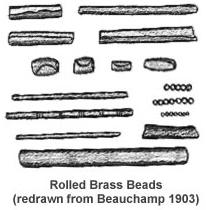
|
Bead Making
|

|
Bead Making
|
 Before European contact, Native Americans in the Northeast were making small spherical beads from natural copper nuggets (Beauchamp 1903, Orchard 1975). There are great quantities of natural copper deposits in the northern regions of Lake Superior and Nova Scotia. Deposits are also found to points west in Virginia, North Carolina, and Tennessee, as well as in the western areas of Arizona and New Mexico.
Before European contact, Native Americans in the Northeast were making small spherical beads from natural copper nuggets (Beauchamp 1903, Orchard 1975). There are great quantities of natural copper deposits in the northern regions of Lake Superior and Nova Scotia. Deposits are also found to points west in Virginia, North Carolina, and Tennessee, as well as in the western areas of Arizona and New Mexico.
Beads made from indigenous copper were both small spherical shapes like those found in New York (Beauchamp 1903), or tubular shapes like those found in Tennessee (Orchard 1975). Even when these ancient copper beads are found in badly corroded condition, the layering of the metal is distinct, and indicates manufacture from copper nuggets (from repeated hammering, flattening, folding and hammering again).
 Other tubular sheet metal beads, rolled with slightly overlapping edges like those found in Tennesee, were made around the time of European contact with Native Americans. The copper for these beads was often obtained from worn out European kettles. These beads vary in size from a quarter of an inch to nearly two inches long and about a quarter inch in diameter (Orchard 1975). Many small brass tubular and rolled tapering oval-shaped brass beads are described by Wray et. al. (1987) for Seneca sites in New York. The brass bead varieties from New England suggest that there are both native-made and traded European-produced varieties in both the small tubular and oval bead forms.
Other tubular sheet metal beads, rolled with slightly overlapping edges like those found in Tennesee, were made around the time of European contact with Native Americans. The copper for these beads was often obtained from worn out European kettles. These beads vary in size from a quarter of an inch to nearly two inches long and about a quarter inch in diameter (Orchard 1975). Many small brass tubular and rolled tapering oval-shaped brass beads are described by Wray et. al. (1987) for Seneca sites in New York. The brass bead varieties from New England suggest that there are both native-made and traded European-produced varieties in both the small tubular and oval bead forms.
 Tubular brass beads of native manufacture appear to have been wrapped around sticks of wood with spongy, or light pithy centers. Crimping the bead around this pithy wood form facilitated the manufacture of these beads, while not prohibiting their later stringing. In their work at Seneca sites Wray, et. al. (1987) note the preserved remains of what have been tentatively identified as reeds. European-manufactured brass beads do not seem to exhibit this spongy wooden center, and were likely wound around metal mandrels in the Old World.
Tubular brass beads of native manufacture appear to have been wrapped around sticks of wood with spongy, or light pithy centers. Crimping the bead around this pithy wood form facilitated the manufacture of these beads, while not prohibiting their later stringing. In their work at Seneca sites Wray, et. al. (1987) note the preserved remains of what have been tentatively identified as reeds. European-manufactured brass beads do not seem to exhibit this spongy wooden center, and were likely wound around metal mandrels in the Old World.
 Beads found in Leweston, Niagara county, New York, indicate their Native manufacture (Orchard 1975). Small strips of copper sheet, probably supplied by Europeans, were bent in tubular form so the edges of the metal were brought together on an even plane, resulting in a diameter of three sixty-fourths of an inch (Orchard 1975). With them were found strung beads about twice as large. The large and small types of brass tubes were strung on separate strings. Some of these tubular beads appear more quickly made, as the edges are often irregular and overlap (Orchard 1975).
Beads found in Leweston, Niagara county, New York, indicate their Native manufacture (Orchard 1975). Small strips of copper sheet, probably supplied by Europeans, were bent in tubular form so the edges of the metal were brought together on an even plane, resulting in a diameter of three sixty-fourths of an inch (Orchard 1975). With them were found strung beads about twice as large. The large and small types of brass tubes were strung on separate strings. Some of these tubular beads appear more quickly made, as the edges are often irregular and overlap (Orchard 1975).
 Residing in a Toronto collection, copper tubes sewn onto a hide with fine thongs are made of rolled sheet copper. In length these beads measured from 3/4 of an inch to an inch, and varied from 3/16 to 5/16 of an inch in diameter (Beauchamp 1903). Beauchamp (1903) illustrates several long, cylindric brass beads from archaeological sites in Fulton County, Pompey, NY.
Residing in a Toronto collection, copper tubes sewn onto a hide with fine thongs are made of rolled sheet copper. In length these beads measured from 3/4 of an inch to an inch, and varied from 3/16 to 5/16 of an inch in diameter (Beauchamp 1903). Beauchamp (1903) illustrates several long, cylindric brass beads from archaeological sites in Fulton County, Pompey, NY.
Beauchamp (1903) also describes an account given by Fray in 1879. He found a necklace or headband, composed of copper and shell beads; the former were made of thin sheet copper rolled into tubes, around which hematite was embedded. The combination of wampum and copper or brass in a headband was probably used after European contact.
Orchard (1975) remarks upon some beads from Hewlett, Long Island, which did not have the appearance of being made from rolled sheet metal, and are probably of European production, most likely of cast metal.

© 1994-1999 Tara Prindle.